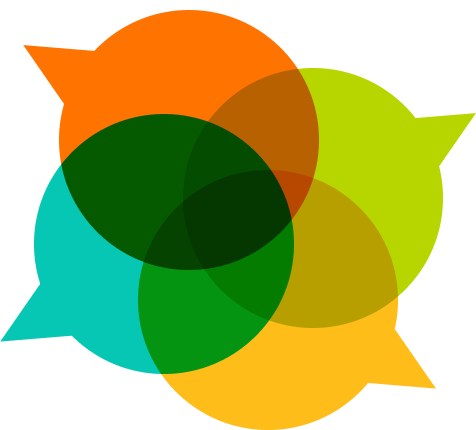Resources for Digital Literacy Programming
Interested in bringing digital literacy to your area?
Dozens of educators and community leaders contributed expertise to create this guide for learning about and preparing digital literacy curriculum. Though these resources work for many kinds of programming, we collected them with learning circles in mind.
Learning circles are free, facilitated study groups for people who want to meet and learn about a topic together. While facilitators don’t need to be topic experts, they should have an idea about what the topic means and how the group will learn about it. These resources are designed to help you figure out the what and how of digital literacy. Learn more about running learning circles here.
For a printable version of this list or the meeting agenda, check out this document.
—————
 Defining the Topic
Defining the Topic
Understanding the core components of digital literacy
-
Common Sense Media: What is digital literacy?
Clear definitions of digital literacy and some of its key skills: searching, privacy, credit, respect, and digital footprints. -
The meaning of digital readiness
This article, part of a larger report on Digital Readiness Gaps, defines the crucial aspects of a learners’ digital readiness—digital skills, trust, and use—and presents helpful stats and measures to consider when introducing this topic.
 Who, Why, & How
Who, Why, & How
Identifying your learners, their motivations, and how you’ll help them succeed
Q: What motivates learners to attend digital literacy programs?
Facilitators running digital literacy programming brainstormed a range of learner outcomes that motivate patrons to improve their digital literacy skills. See responses and your own in AnswerGarden. (list view)
Questions for reflection and planning:
- Demographic: Who are the learners you aim to support? What specific needs, strengths, and weaknesses should you consider in creating learning opportunities for them?
- Context: Where and how will this education take place? What barriers exist to making this accessible to your learners?
- Autonomy: How do we engage learners in this process to make sure their unique personal outcomes and goals are being met?
 Facilitator Prep Resources
Facilitator Prep Resources
Tips for educating yourself and facilitating this topic
-
5 Dimensions Of Critical Digital Literacy: A Framework
This dedicated site explains a framework for digital literacy curriculum based on an established model of critical literacy skills and provides workshop-style activities, analytical tools, and resources for running your own program. Download the research paper (1.7MB, PDF) -
7 Ways to Teach Digital Literacy
A helpful list of mindsets and strategies for educators teaching digital literacy. This article acknowledges that technology is often unintuitive and that mastery comes from learning, experimenting, and practicing. -
Tips for Helping Someone Learn to Use Technology
A librarian’s strategy guide for helping patrons use technology both in-person and remotely.
 Courses & Other Learning Materials
Courses & Other Learning Materials
Free and adaptable online courses/curriculum
-
DigitalLearn.org (English, Spanish)
DigitalLearn.org is an online hub of self-directed tutorials to build core digital literacy proficiencies and intermediate applications of those skills (like safety, applying for jobs, and productivity). Modules are video-based with narration (6–22 minutes long) and written in plain language (communication learners can understand the first time they hear or read it), often at an elementary to middle school reading level. -
GCFLearnFree.org (English, Spanish, Portugese, French, Russian, Mandarin, Norwegian, Indonesian, Greek, Arabic, Kyrgyz, Dutch)
Free self-paced courses (tutorials, videos, and games) covering over 200 topics including digital literacy basics. They also offer free Teacher Guides to support effective use of their content. -
TechBoomers (English)
Free courses, step-by-step tutorials, and informational articles to teach learners about specific web platforms. TechBoomers also offers detailed libraries of Digital Literacy and Internet 101 guides and articles, though they can be overwhelming to navigate. -
Oasis Connections (English, Spanish)
A nonprofit educational organization focused on promoting healthy aging through lifelong learning, active lifestyles and volunteer engagement.- Oasis Connections on YouTube: Playlists of short infographic style videos about digital equipment and online security.
- Mobile Accessibility Guide: Free PDF manuals and videos that show how to improve accessibility on a variety of mobile devices.
- Course List and Manuals: Oasis offers a wide range of regularly-updated training manuals for different topics (see course list) but most are not free for the public to access.
 Strategies in Practice
Strategies in Practice
Experienced facilitators’ advice for a successful program
Reaching patrons with limited digital literacy:
- Set up varied channels of support (helpdesk email, virtual office hours, phone number, etc.) and include options for contacting outside of working hours
- For folks who are left behind from digital-first initiatives, start with phone calls and ease them into virtual spaces
- Develop gentle pathways to participation (e.g. if you’re collaboratively drafting a Google Doc, some people may prefer to participate by answering specific questions in a form rather than jumping in and editing a document)
Accessibility:
- Avoid making assumptions about learners’ current digital skills or priorities: if possible, focus on identifying individuals’ objectives and barriers (money, anxiety, access, lack of support) to create effective and meaningful programming
- Understand and acknowledge the overlaps and distinctions between various forms of modern literacy
Programming:
- Incorporate online safety into all aspects of training (rather than calling it out as a separate topic).
- Promote with the end goal in mind. For example, rather than designing a program under the broad banner of “digital literacy”, consider framing it around helping seniors engage in safer online behaviors.
